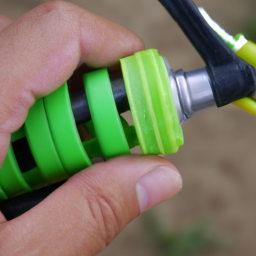How To Fix Garden Hose Spray Nozzle
How To Fix Garden Hose Spray Nozzle
When Your Garden Hose's Spray Nozzle Goes Haywire, Restore it to its Former Glory
Having a powerful water spray for your garden hose is key to keeping your yard in tip-top shape. But when you find the spray nozzle malfunctioning, it can be a frustrating experience. Before giving up hope and heading to the garden center for a replacement, try these steps to bring your nozzle back to life.
1. Unscrew the Nozzle
The very first step to troubleshooting a garden hose spray nozzle is to identify if the problem is coming from inside the nozzle itself. The best way to do this is to unscrew the nozzle from the hose ends and examine it.
2. Determine Any Damage
If you find any underlying damage or debris clogging the nozzle, it's likely causing the malfunction. Usually, foreign objects such as small pebbles, grass, and sand particles can infiltrate and clog the nozzle.
3. Clean Inside for Delicate Parts
If you can see any metal parts on the inside of the nozzle, use a wooden toothpick to gently remove any blockages. Any sign of leaking can be repaired with pipe tape or other plumbing tape.
4. Check O-rings and Gaskets
The O-rings and gaskets of the nozzle are the most prone components to wear and tear. It's time to check the O-rings and gaskets if you're experiencing issues with the water spray. Damage can make it difficult to properly tighten the nozzle and cause water to leak. Replacing these components is easy and relatively inexpensive.
5. Analyze Component Compatibility
Before buying any key components, make sure to check the compatibility of the nozzle and replacement part. Many nozzles come with different sizes of O-rings, gaskets, and segments that may not fit a universal part.
6. Allow to Soak in Vinegar
If the above solutions don't pan out, try giving the nozzle a soak in white vinegar overnight. The acidity of the vinegar can eat away at the dirt and debris causing the issue.
7. Replace the Nozzle Completely
If nothing else works, it's time to replace the nozzle and start afresh. Make sure the new nozzle is the same size as the old one and fits your hose without any issues.
Tools to Help with Nozzle Repair
The tools you need for troubleshooting and replacing your nozzle are few and easy to find. Get a set of insulated pliers, a wooden toothpick, O-ring grease, pipe tape, and replacement nozzles to have on hand for future repairs.
Safety Tips
Garden hoses usually connect to a mains water pipe and may have high water pressure. Take adequate safety precautions to avoid any further damage or injury, such as disconnecting the hose from the main water supply.
Brief Recap
When your garden hose nozzle starts to malfunction, there are a few steps you can take before investing in a new one. Start by examining and cleaning the nozzle before moving on to inspect the O-rings and gaskets. Allow the nozzle to soak in white vinegar and make sure to get replacement parts that fit. If all else fails, replace the hose nozzle completely. Be sure to equip yourself with the right tools and safety measures before starting repairs on any garden hose.

Previous Page
Next Page
